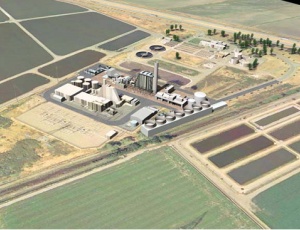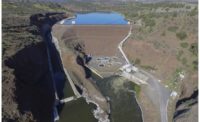A ceremonial groundbreaking took place this week for the $452-million Lodi Energy Center power plant project in northern San Joaquin County.

The California Energy Commission and Northern California Power Agency teamed up to get the project off the ground, and the NCPA will construct, own and operate the plant. The center will be a natural gas-fired, combined-cycle nominal 255-megawatt power generation facility.
The site for the LEC project is 4.4 acres of land in the city of Lodi, 6 mi west of the Lodi city center near Interstate 5. On the east side of the site is the city of Lodi�s White Slough Water Pollution Control Facility (WPCF). The WPCF�s treatment and holding ponds are located to the north; an existing generating plant, the 49-megawatt NCPA Combustion Turbine Project, is located to the west with a 230-kV Pacific Gas and Electric overhead electrical transmission line aligned further to the west, and the San Joaquin County Mosquito and Vector Control facility to the south. The city of Stockton is approximately 2 mi south. The project site is currently undeveloped and used for equipment storage during upgrades to the WPCF.
Ken Speer, assistant general manager-generation services for the NCPA, says the general contractor on the project is ARB of Lake Forest, and the �detail� engineer is WorleyParsons, the Australia-based firm with 120 offices worldwide, including one in Sacramento.
Completion is scheduled for June 2012.
According to the NCPA, the available workforce in the Stockton Metropolitan Statistical Area will be adequate to fulfill the center�s construction labor requirements. Sixty percent of the construction workforce will come from within San Joaquin County, with the remaining workforce to be drawn from other nearby counties, especially those in the San Francisco Bay Area or from out of state. There will be an average of approximately 168 daily construction workers, with a peak daily workforce of 305 during the 24 months of construction.
The project is a combined-cycle generating plant consisting of one natural gas-fired Siemens STGS-5000F combustion turbine-generator (CTG), with an evaporative cooling system and dry low-NOx combustors to control air emissions; one three-pressure heat recovery steam generator (HRSG); a selective catalytic reduction (SCR) and carbon monoxide (CO) catalyst to further control NOx and CO emissions, respectively; one Siemens SST-900RH condensing steam turbine generator (STG); one natural gas-fired auxiliary boiler; one seven-cell draft evaporative cooling tower; and associated support equipment.
Speer says the center will be designed to use �Flex Plant 30� rapid startup technology, which is designed to allow earlier startup of the steam turbine by decoupling the gas turbine from the HRSG, essentially reducing startup emissions.
The project is expected to have an overall annual availability of more than 95%. The CTG and associated equipment will include the use of best available control technology (BACT) to limit emissions of criteria pollutants and hazardous air pollutants. An SCR system using ammonia injection will help control NOx (nitrogen oxide) and volatile organic compounds. BACT for PM10 (particulate matter) and SO2 (sulfur oxide) will be the exclusive use of natural gas, and ammonia will also be limited to 10 parts per million.



Post a comment to this article
Report Abusive Comment